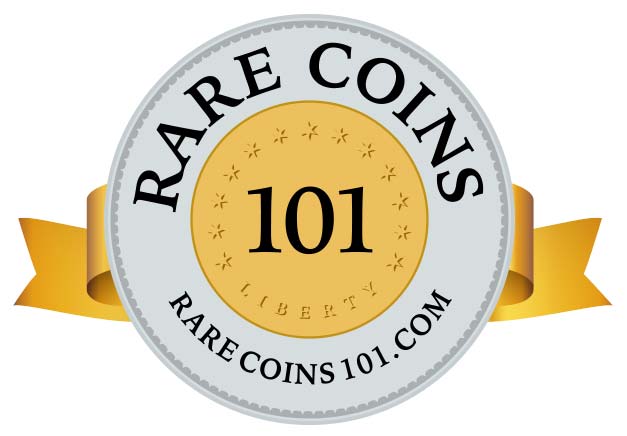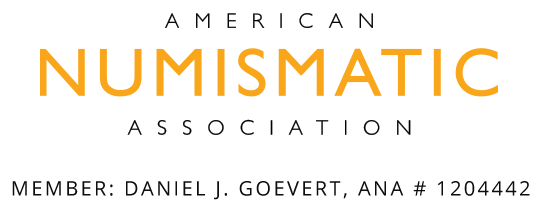1879-CC Coronet $5 Half Eagle
By the late 1870s, the Carson City Mint’s reputation was in shambles. It was commonly understood the “CC” operation was plagued by manufacturing inefficiencies, embezzlement allegations, and political gamesmanship.(1)
Moreover, the transportation costs for raw bullion from Nevada mines to Carson City were outrageous, despite their geographical proximity. Shipping to the San Francisco Mint was a more profitable option for many mining companies.(2)
According to Carson City Mint scholar Rusty Goe, "By 1879, Nevada's miners were already sending about 100 times as much of their gold to the San Francisco Mint than they were depositing in Carson City, and about 13 times as much silver."
This accounts for the limited number of gold coins minted in Carson City during 1879. The Nevada branch produced only 17,281 half eagles, which stands in stark contrast to the 426,200 five-dollar coins issued the same year by the San Francisco facility – a record high quantity at the time.(3)
Virtually the entire mintage of the 1879-CC half eagles was quickly absorbed into the economy and circulated heavily. Many years later, when collectors finally started specializing in mintmarks, nearly all of the 1879-CC half eagles had perished.
The 1879-CC half eagle in any condition is considered a rarity, but no more than half dozen specimens are known to exist today in Mint State.(4)
Carson City half eagles from the early 1870s generally command more attention and higher prices than the 1879-CC, but check out the charts below.
In recent years, the 1879-CC has been moving higher and at a swift rate. It will never catch up to the 1870-CC half eagle, but the 1879-CC is a prestigious coin with tremendous upside potential.
| Estimated survivors in all grades: 250 ?
The survivor estimate from PCGS represents an average of one or more experts' opinions as to how many examples survive of a particular coin in all grades. Survival estimates include coins that are raw, certified by PCGS, and certified by other grading services. Learn more at PCGS. |
| PCGS Rarity Scale: 6.6 ?
The 'PCGS CoinFacts Rarity Scale' assesses the relative rarity of all U.S. coins, based on estimated surviving examples. The scale runs from 1.0 to 10.0. The higher the number, the rarer the coin.
Learn more at PCGS. |
| Search for the 1879-CC Coronet $5 Half Eagle on eBay** |
Preview of eBay selection (don't give up finding one until you try the Search link above):
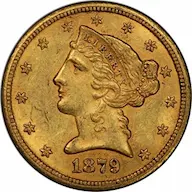 |
 |
| Trendline Avg = 13.30 | GOOD |
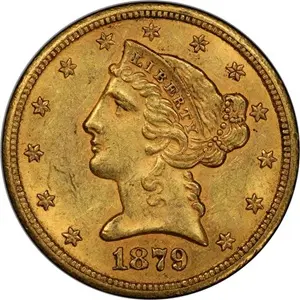 |
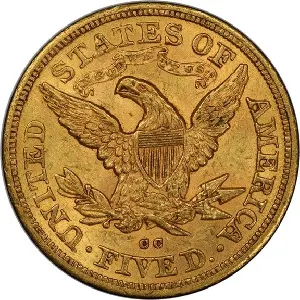 |
| Trendline Avg = 13.30 | GOOD |
Historic Value Trend Charts:
| Last updated 8-11-25 | Return to Key Date Coin List | |
| Compare to Common Date Coin of Same Type | ||
|
|
||
| Download Charts to Your Computer | ||
Sources
1. The Effect of the Gilded Age on the Carson City Mint. The Texas Digital Library, Sam Houston State University (1970).
2. Stack’s Bowers Galleries. 1879-CC Liberty Head Half Eagle. Apr 2022 Auction.
3. Stack’s Bowers Galleries. 1879-CC Liberty Half Eagle. Aug 2012 Auction.
4. Heritage Auctions. 1879-CC $5. Jan 2025 Auction.
**Many very fine coin dealers sell on eBay. At any point in time, there may be over one million search results for United States coins. This includes quite a few of the recommendations on our Key Date Coin List.
If you’re thinking about purchasing a rare coin, eBay is certainly worth a look. For your convenience, the links from this site to eBay are coded to bring up only coins certified by PCGS and NGC.
As is always, always the case, never buy a valuable coin from a seller whose trustworthiness cannot be verified. Learn more about this at our chapter Best Places to Buy Coins, which also has a section on doing business on eBay.
In the interest of full disclosure, Rare Coins 101 receives a small commission anytime someone connects to eBay from this site and purchases something.
Coin images by Stack's Bowers Galleries.

